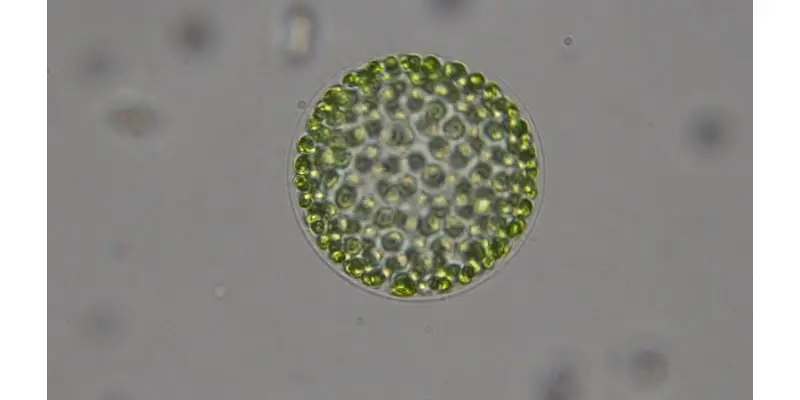Volvox are a genus of green algae within the family Vovlocacae that exists as a spherical colony of over 50,000 cells. The genus can be found within freshwater habitats such as ponds, puddles, ditches, and more. Volvox can grow to 500 micrometers in diameter which means that it is possible to see them without a microscope when fully grown.
Understanding the life of algae is particularly challenging. It’s difficult to comprehend how such a small organism can have such a large impact on the world that we live in. This article is intended on giving you a deeper understanding of the green algae known as the Volvox.
What are the Most Common Types of Volvox?
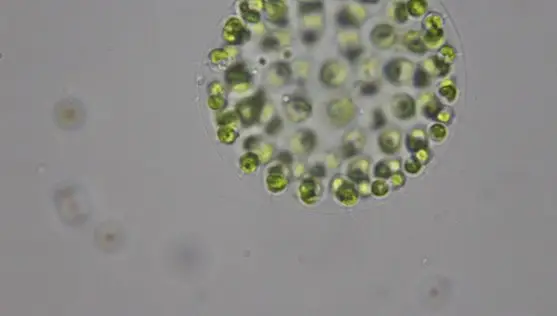
There are approximately 20 species of Volvox. Of those 20, the most common species and their characteristics are listed below:
- Volvox aureus: A smaller species of Volvox that has fewer individual cells than normal. They typically grow to approximately 0.5 millimeters in diameter which makes them just barely visible to the human eye. The individual cells of this species are egg-shaped.
- Volvox globator: This species can reach up to 2 millimeters in diameter and can be seen without a microscope. Although smaller than the Volvox aureus, its individual cells are actually smaller in size at four microns in diameter.
- Volvox carteri: Discovered in 1878, this species of green algae is used as a model organism to help deepen our understanding of evolution and cellular differentiation. This is mainly because the species only has two types of cells. Their biflagellated somatic cells cannot divide and are mobile. The Gonidia are immobile and are thought to be immortal thanks to their ability to divide and reproduce.
- Volvox barberi: This species is known as the fastest amongst their Genus. It is the largest species in terms of cell number and colonies can contain anywhere from 10,000 to 50,000 individual cells. They are uniquely negatively buoyant, which means that they must constantly swim to stay afloat. They can move through the water column at a top speed of 3 mph.
Volvox have been used for centuries as model organisms for their unique reproductive abilities and incredible speed. The colonial behavior of the individual cells is thought to be how unicellular organisms transitioned into multicellular organisms. These are just four of the 20 species of Volvox currently classified. Many of the species are not well studied.
How do Volvox Produce Energy?
Volvox do not eat in a traditional sense. They do not have a mouth to eat from and do not have an anus to excrete from. Instead, the Volvox eats mainly through photosynthesis. This means that Volvox are capable of converting sunlight into energy as primary producers.
Because of their photosynthetic tendencies, the Volvox is rarely observed living in heavily shaded areas. Their mobility allows them to seek out sunlight. Likewise, they are not often found in deep waters where the sunlight cannot reach them. There are two types of photosynthesis that may occur: oxygenic photosynthesis and anoxygenic photosynthesis. Volvox convert sunlight into usable energy mainly through oxygenic photosynthesis.
During this process, sunlight transfers electrons within water and carbon dioxide to produce sugars or carbohydrates. Carbon dioxide is released in the process while oxygen is created. It’s this process that balances respiration between humans and plants. Humans breathe oxygen, while plants breathe carbon dioxide.
What is the Structure of Volvox?
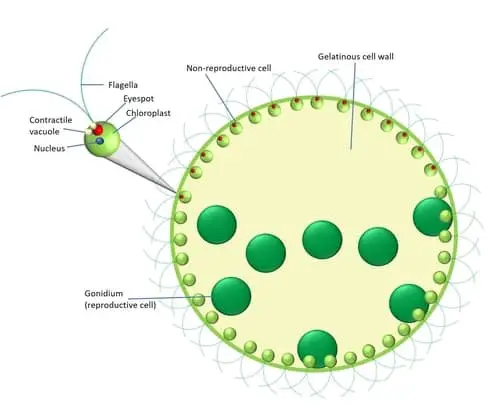
The image above will help you better understand the Volvox’s structure and behavior. Each part of the Volvox structure is explained below:
- Flagella: Flagella are hair-like protrusions from the cell body whose primary function is for locomotion but can also specialize as a sensory organelle or means of grabbing or attaching on to something else. In the Volvox, there are two equally sized flagella that make up the anterior of the colony. The two flagella are initially within the cell during division but invert through colony inversion so that they stick outwards. The outward flagella allow the colony to swim in unison towards sources of sunlight. The coordinated effort and its ability to spin through the water effortlessly is widely studied in modern science.
- Contractile Vacuole: The contractile vacuole is responsible for osmoregulation. It’s an organelle of free-living organisms that balances water from within the cell that gives it rigidity and allows it to withstand the pressure from being underwater. In some organisms, the vacuole assists in locomotion but does not in the Volvox.
- Eyespot: The eyespot is on the front side or the ‘north pole’ side of the Volvox. It allows the Volvox to know where the sunlight is coming from so that it can swim towards it. It’s not a traditional eye as you see in humans or other animals, rather is only capable of identifying which direction photosynthetic light is coming from. Without the eyespot, the Volvox would not know where to swim for access to light.
- Nucleus: A cell nucleus is unique to eukaryotic cells. It contains all of the cell’s genetic information, which is organized in long, hexagonal strands known as DNA. The nucleus is capable of dividing and sharing genetic information with sexual partners. It is also capable of dividing asexually in certain species of Volvox.
- Chloroplast: This is the organelle responsible for undergoing photosynthesis. It appears green in color thanks to its pigmented chlorophyll. The chlorophyll help capture light energy and convert it into ATP and NADPH while releasing oxygen from carbon dioxide back into the surrounding environment. Chloroplasts contain their own DNA and were thought to have once been their own individual type of cell.
- Gelatinous Cell Wall: The gelatinous cell wall is a layer of bi-flagellated somatic cells. The gelatinous layer has a jelly-like consistency and allows organelles to move around while providing some rigidity and structure.
- Gonidium: The gonidium is an asexual group of cells in colonies of Volvox. Gonidia are not mobile and eventually create new colonies through repetitive divisions. The gonidium is widely studied by modern science.
- Cytoplasm: The Volvox use long strands of cytoplasm to link together with other individual cells and create a colony. The colony uses the cytoplasm to transmit signals so that it can move as one large organism.
How Are Volvox Classified?
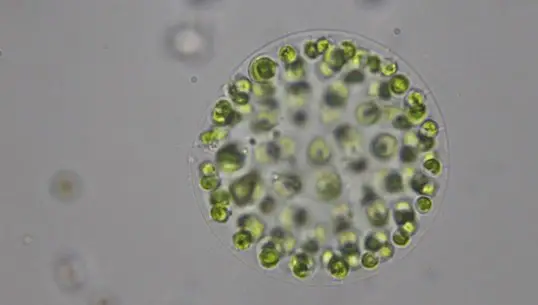
All life on earth is classified into unique groups depending upon distinguishing characteristics. Each group can further be subdivided into smaller groups. Groups are divided further and further based on the organism’s characteristics until they cannot be subdivided any more, which is where species come from.
The classification system for organisms can be broken down into seven different levels: kingdom, phylum, class, order, family, genus, and species (in that order). Kingdoms are the most basic classification of living things. There are five kingdoms in total. A phylum is the first attempt at narrowing down the list of organisms based on a physical similarity, which suggests that there is a common ancestry among similar organisms. Classes, orders, families, and genus are all narrowed down even further based on similar traits until we finally get to a single species.
Since Volvox is a genus, they can further be broken down into species. Volvox belongs to the Domain Eukaryota, the Kingdom Plantae, the Phylum Chlorophyta, the Class Chlorophyceae, the Order Chlamydomonodales, and the Family Volvocaceae. Each classification is further explained below as it related to the Volvox:
- Domain: Eukaryota – Many are most familiar with this Domain as it includes all plants, animals, fungi, and protists. Eukaryota display an incredible amount of diversity in their physical shape and characteristics as well as cellular organization, chemistry, and biology. They are all complex structures encased with membranes and can be either single-cellular or multi-cellular. The presence of the nucleus makes the Eukaryota particularly special.
- Kingdom: Plantae – This Kingdom is most recognizably comprised of living organisms such as trees, flowers, bushes, ferns, mosses, and green algae. Most living organisms that obtain their energy through the process of photosynthesis are grouped within Plantae. They have a unique organelle called a chloroplast which consists of chlorophyll that gives them their distinctive green color.
- Phylum: Chlorophyta – This taxonomic group consists of green algae called chlorophytes that live in mainly aquatic environments. Some green algae species have adapted to living within precipitation on mosses or other plants and even within the most extreme environments on earth. They are a highly adaptable group of organisms that have flagella which helps with their movement. There are approximately 11,300 total species of green algae that make up this Phylum. There is some debate amongst this classification, and it can be further subdivided into chlorophytes and charophytes. Chlorophytes live in salty environments whereas Charophyta lives in freshwater habitats as well as on land.
- Class: Chlorophyceae – This class of green algae was subdivided because of their ultrastructural morphology. They have unique arrangements of flagella. In some clades, flagella are displayed in a clockwise orientation. Others have counterclockwise rotations. This is thought to be because of dominance in either “chlorophyll a” or “chlorophyll b”. Generally, Chlorophyceae are either unicellular, colonial, or multicellular. They are typically green and disc-shaped, cup-shaped, spiral-shaped, or ribbon-shaped. They have an inner cell wall lining comprised of cellulose and an outside film of pectose and can reproduce either asexually or sexually.
- Order: Chlamydomonodales – Also known as Volvocales, this Order is comprised of flagellated green algae that often form planar or spherical colonies. Some colonies are Gonium (four to 32 cells) all the way up to the Volvox (500+ cells). Each cell uniquely consists of two flagella which helps it move and stay coordinated with other cells. Reproduction is still either asexual or sexual. Cells continue to split until they make up a new colony. Once a new colony is fully formed, it is released to become its own colony.
- Family: Volvocaceae – This Family is uniquely known for colony inversion. Colony inversion is a special characteristic that is expressed during the colony’s development. When cells begin dividing, they form a concaved-shaped embryo that is made up of one single cellular layer, which is inside out from the adult configuration. The embryo then undergoes inversion where it inverts and forms a sphere with its flagella positioned on its outside. Spherical colony inversion is thought to have evolved twice throughout the history of the Chlamydomonodales.
- Genus: Volvox – Volvox exists as a spherical colony where each individual cell consists of two flagella which help with locomotion. Each one is attached to one another by thin strings of cytoplasm that enable the Volvox to move about as a single unit. Each colony can be distinguished by a front side and a back. In comparison to planet earth, each colony has a north pole and a south pole. The front side, or north pole, has an eyehole that helps the colony move towards the light to aid in photosynthesis.
- Species: Variable – Volvox can then be narrowed down into just 20 species of algae.
Where do Volvox Live?
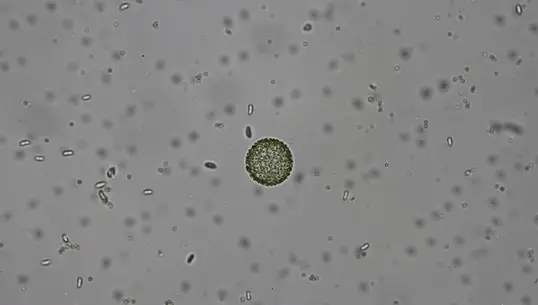
Volvox are commonly found within deep ponds, lagoons, puddles, ditches, swales, and more. They tend to thrive in areas that receive a large amount of rainwater. They choose to live within nutrient-rich water and grow rapidly in the warmth. Volvox are commonly observed in pond scum. If you pick up a handful of pond scum and squeeze out the water, you’ll likely see the Volvox swimming upwards towards the light.
How do Volvox Reproduce?
Volvox are widely regarded in the scientific community as a model species thanks to their unique reproductive tendencies. They have the ability to reproduce both sexually and asexually. Asexual reproduction is the most common means of reproduction amongst the Volvox. Favorable or unfavorable environmental conditions will result in either asexual reproduction or sexual reproduction. In the wild, it is unknown what the ratio is between asexually reproduced Volvox and sexually reproduced Volvox.
A sex-inducing pheromone is also capable of triggering an asexual or sexual reproduction. The pheromone is mostly given off as a result of heat shock which is facilitated by oxidative stress. The stress may cause damage to the Volvox’s DNA. The sex-inducing pheromone is thought to have been key in the Volvox surviving through long periods of drought and extreme heat. Lastly, the pheromone may also be given off if the Volvox is wounded.
Asexual colonies of Volvox consist of both somatic and gonidia cells. The somatic cells are vegetative and completely incapable of reproduction. Although not capable of reproduction, somatic cells are mobile and serve their own unique purpose. The gonidia, on the other hand, are not mobile. They are responsible for producing life to new colonies as they rapidly and repeatedly divide.
During sexual reproduction, both monoecious and dioecious colonies are brought to life. Monoecious colonies have both male and female reproductive organs and are hermaphrodites. Dioecious colonies have a sex assigned to them, whether male or female. The male colonies release sperm into the surrounding water while the female colonies have specialized cells that enlarge and become eggs. The sperm then fertilizes the eggs, and the eggs are released back into the water until they hatch and mature. Colony inversion, as discussed previously, is the unique way in which the embryo of the reproductive cells invert.
During their first stage of division, they form a mushroom cap or cupped appearance. From there, they invert themselves so that their insides are positioned outwards. During this process, the inward-facing flagella are inverted to face outwards. Without this crucial step in the reproductive process, the Volvox would not have access to its flagella for movement.
When Were Volvox First Discovered?
There is not much known about the origins of Volvox. As with many microorganisms, Volvox was thought to have been first observed by a Dutch businessman turned scientist named Antoine Philips van Leeuwenhoek over 300 years ago. The origins of the Volvox are often confused with the ‘cousin’ of the Volvox, otherwise known as ‘Chlamy’, or the Chlamydomonas reinhardtii.
In 1700, van Leeuwenhoek wrote a letter that revolved around parasitic worms in sheep livers, gnats, and the excrements of frogs. Within this letter to the Royal Society of London are descriptions of an organism thought to be the Volvox. Leeuwenhoek wrote that they were, “a very pleasant sight” and that he “did fancy at first that they were animals”. He also called them, “great round particles”. Leeuwenhoek likely thought that Volvox were animals because of their ability to ‘roll’ or ‘spin’ through the water at high speeds thanks to their two flagella).
Carl Linnaeus, a Swedish scientist who is credited with the creation of binomial nomenclature, gave the Volvox the nickname ‘fierce roller’ because of this behavior. Binomial nomenclature is a system used to denote living organisms by species by first indicating the genus and then the specific epithet. Linnaeus classified the Volvox in the order Zoophyta within the class Vermes. Volvox joins the likes of Cnidarians, Bryozoa, and tapeworms.
Are Volvox Dangerous to Humans?
Volvox are not directly harmful to humans. They are too small to present any harm to us and do not have any weapons or poisons that are capable of hurting us. On the other hand, Volvox are capable of forming algal blooms which can harm the ecosystem. Algal blooms may be responsible for the deaths of fish, mammals, birds, and other aquatic organisms. Since Volvox are algae that prefer to live in mineral-rich habitats, they occasionally grow so rapidly and abundantly along with other algae that they cause harm.
Algal blooms deplete the oxygen from the water and block sunlight from reaching vegetation down below. Depending on the type of algal bloom, they can release harmful toxins that create dead zones in the water. Subsequently, algal blooms cause an increase in treatment costs for drinking water.
How to Observe Volvox Under the Microscope
Volvox are quite easy to find. If you scrape algae off the top of a pond or the edge of a lake you are very likely to find Volvox in the sample. Volvox move very slowly to it is easy to observe them at very high magnifications. At 600X magnification and above you can observe the eyespots on the north side of the Volvox. If you close your iris diaphragm more than you normally would at high magnification you will also be able to clearly see the flagella and the motion that enables them to move in a circular motion.
Because of their spherical shape it can be difficult to get a clear picture of the entire cell unless you have some good flat field corrected objective lenses. If you have never observed Volvox under the microscope I would highly recommend seeking these microorganisms out because they are extremely interesting to observe in action. Run out your favorite pond or lake and snag a sample today!
References
- https://pubmed.ncbi.nlm.nih.gov/27039854/
- https://academic.oup.com/jhered/article/105/1/143/858312
- https://www.ncbi.nlm.nih.gov/pmc/articles/PMC5765864/
- https://www.reference.com/science/volvox-eat-3bd9708e98b05171#:~:text=The%20volvox%20primarily%20eats%20through,consists%20primarily%20of%20other%20algae.
- https://biologywise.com/volvox-facts

